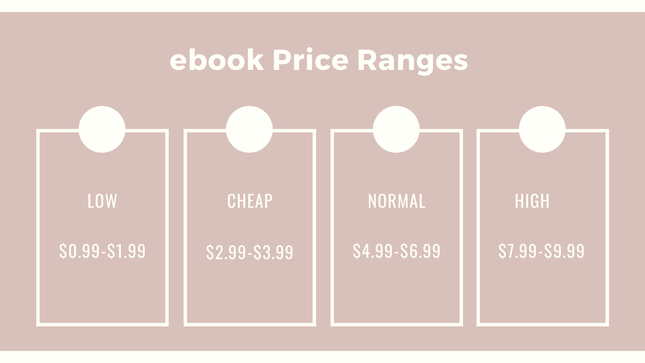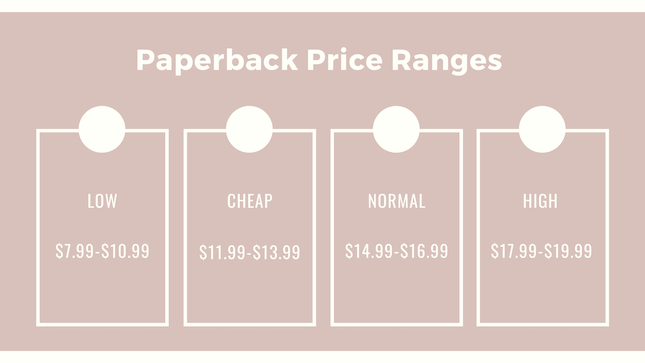
Pricing Your Novel to Generate Sales
How much should a self-published novelist charge for their book? The answer lies in a number of decisions you make about what you want to accomplish with your novel. Before you decide, you should answer some questions to make sure you are not selling yourself short or pricing your book out of the market.
Choosing the right price for your self-published book is a crucial marketing decision. Your price is the final buying decision a reader makes after being attracted to your cover and reading your book description blurb.
Questions to Determine Your Novel's Price
1. What is your book worth?
This isn't the time and expenses you put into producing your novel, but the book’s value in the market. Research similar books in your genre, allowing for word count, size, and production values. Established best-selling authors may have premium prices, but if you are just starting out, stay with the going prices of other books in your genre.
2. What is your financial goal?
Balance making a profit on your first novel with gaining readers. Many authors price their first book at an inviting low price to garner readers, and some, with a series, make the first book in the series 99 cents or free to entice readers into the series.
Research Your Competition
Your genre and the competition in your genre will help you determine your price. SciFi and Fantasy are often big, long books while cozy mysteries are often short novels. Your price depends on what readers expect and will pay in your genre, not on the length of your novel.
See what other authors charge in your genre. If this is your first novel and only novel so far, choose a price in the lower range to entice new readers. Spread the word and market your book while you write the next one.
Be careful though: price affects the perceived quality of your book. Try to find a price that is just below those for established titles in your genre, but don’t be tempted to undercut to the point of looking cheap or lowering the overall value of the genre.
Know What You Will Make
You must make two pricing choices, one for eBooks and another for print books. Let’s drill down on how you are paid for each to gain a better understanding of how to price your novel in each format.
eBook Pricing and Royalties
Amazon and other online retailers like Draft2Digital and PublishDrive charge a commission for each book sale. What you receive after they take their commission is your royalty on the book. You’ll want to price your book high enough so that each sale results in a royalty.
Amazon has two royalty schedules on eBooks:
- 35% royalty: the Amazon sales commission is 65% for eBooks priced below $2.99 and above $9.99
- 70% royalty: the Amazon sales commission is 30% for eBooks priced between $2.99 and $9.99
Amazon also charges you a delivery fee for each eBook sold based on the size of the eBook file. Amazon charges $0.15 per megabyte (MB) for each book priced between $2.99 and $9.99. There is a minimum charge of $0.01, and delivery fees vary by country. There is no delivery fee for books priced below $2.99 or above $9.99.
These numbers are a bit of a nightmare to calculate for yourself. Fortunately, Amazon gives you an estimate of the delivery cost for your book which takes some of the hassle out of working out the effect they'll have on your book price.
You don’t have to publish your eBook directly with Amazon. Online book aggregators like Smashwords, Draft2Digital, and PublishDrive charge a percentage commission and deliver to Amazon as well as other retailers like Kobo, Apple Books, Google Books, and more. Each aggregator charges a small commission. Check for details with each supplier, and see which one suits you best.
Make Your Decision
Your novel deserves the best price for all the work you’ve done and the expenses you’ve spent on editing and cover design. Do your competitor research, get an idea of your royalties, and then go ahead and price your book.

Paperback Pricing and Royalties
If this is your first time publishing, KDP Print at Amazon is straightforward and calculating your cost is more direct than for eBooks. You need to still do the same two stages as for eBooks: research competition prices and set your financial goal. Then calculate your production cost to set a reasonable price.
Manufacturing Cost
The manufacturing cost is calculated with three variables:
- The country where your book is sold
- The number of pages in your book
- Whether you are printing the interior in color or in black and white
Neither your paper choice (cream or white) nor the dimensions of your book affect the cost. It doesn't matter if it is 8.5″ x 11″ or 4.25″ x 6″, the manufacturing cost is the same. KDP’s formula is:
fixed cost + (page count * per page cost) = printing cost
More math! Luckily, KDP supplies three ways to calculate it:
- Upload your files to KDP Print and their calculator will give you a cost.
- Use Amazon’s pricing tables. You’ll do some simple math here (I've added an example below to help you out with this).
- Download the KDP Print Excel spreadsheet print cost calculator.
Image by Author Imprints

Once you determine your printing cost, you can examine royalties – the final piece of the puzzle.
Amazon offers a 60% royalty for paperbacks. Once you know your production cost, subtract it from Amazon’s 60% commission to figure the best price range for your book. You don’t want to price it lower than the cost of getting your book to a reader.
The formula to determine how much you will make on each book is simple:
(list price x 60% Amazon commission) – printing costs = royalty
If you’ve determined the price range for your genre, use that price and the formula to see what you will receive.
For example, if books in your genre are selling at $14.99, multiply $14.99 by 60% to get $8.79.
(14.99 x 60%) = 8.79
Then subtract your printing cost: let’s estimate this at $4.19. Your royalty will be $4.60.
8.79 – 4.19 = 4.60
Remember, these are arbitrary numbers used as an example. Your numbers will be different.
You might decide to use Amazon to sell to other retailers through Ingram with expanded distribution. If you do this, your royalty rate is lower at 40%. This is personal choice, though that lower royalty rate is worth keeping in mind.
Distribution
Some authors choose to use KDP for Amazon sales and distribute their paperbacks with IngramSpark through other channels. At IngramSpark you pay a one-time set up fee of $49 but the calculations are the same.
IngramSpark offers opportunities to sell through bookstores and libraries, as well as online. So if you are looking for broad distribution or you dream of seeing your book for sale in a bookstore, you might consider Ingram.
You have the ability to set the discount for distributors to between 30% and 50%. Bookstores look for a discount between 50–55%.
PRO TIP: If you choose the dual option of Amazon and IngramSpark, be aware that you will need two different ISBNs, one for each distributor.

Your Book, Your Price
Once you publish your book, you are in the business of being an author. Now that you know some basics about pricing your self-published book, you can consider your long-term strategy before you make a final business decision.
This pricing decision helps you determine your financial goals.
If you are looking to maximize book sales, consider prices in the lower range: for example, your eBook at $3.99 and your paperback at $10.99–$12.99. These prices work well for a first-time author with only one book.
If you want readers to see you as a valuable but not overpriced author, go for mid-range pricing. This might look like $6.99 for eBook and $13.99–$16.99 for paperback, and would be good for an author with a strong following and a backlist of five or more books.
If you are looking for status, say for a non-fiction book, then set your prices higher with an eBook at $9.99 and paperback between $17.99–$19.99.
Whatever strategy you choose, if it doesn't work out you always have the option to set a new price and experiment until you find what works for you.

